Eurocom Racer: Why the Radeon HD 6970M Rocks
by Jarred Walton on March 17, 2011 3:00 AM ESTGaming Performance: HD 6970M Nipping at the Heels of GTX 485M
If you’re looking for a mobile workstation—you know, like the Racer only with the Quadro FX 5000M in place of the consumer oriented HD 6970M or GTX 485M—then gaming performance is largely meaningless. You can refer to the HP EliteBook 8740w results as a rough estimate of where such a GPU lands in the gaming hierarchy, but without Sandy Bridge it might be somewhat slower in a few titles. For those looking to buy the Racer as a gaming notebook, this page is for you. It’s also for anyone wondering how AMD’s latest and greatest mobile GPU compares to NVIDIA’s power monster GTX 485M. After the 485M leapfrogged the previous generation mobile hardware, we were a little concerned that AMD might not be able to keep pace; our concerns it appears are unwarranted.


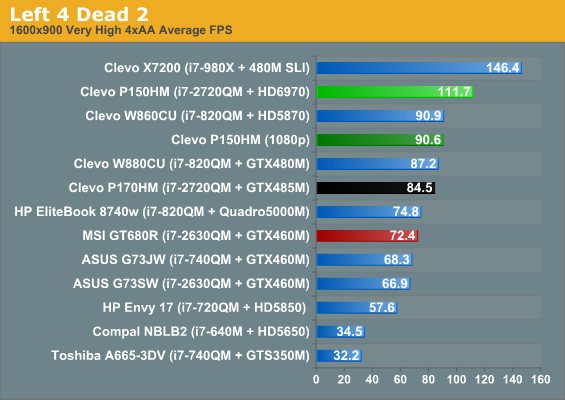
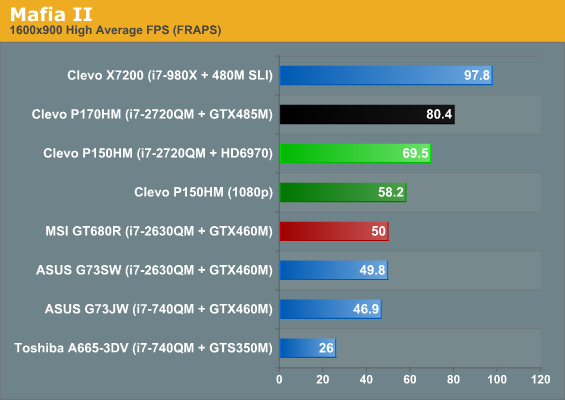
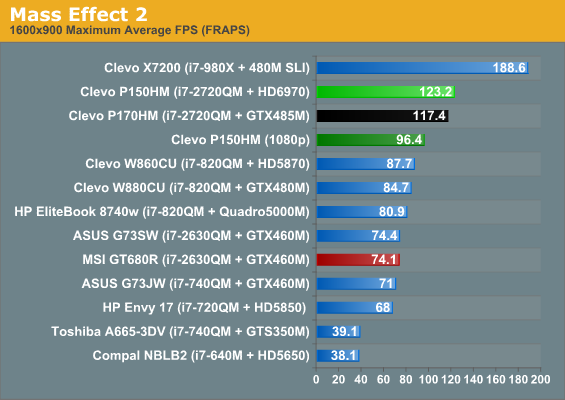


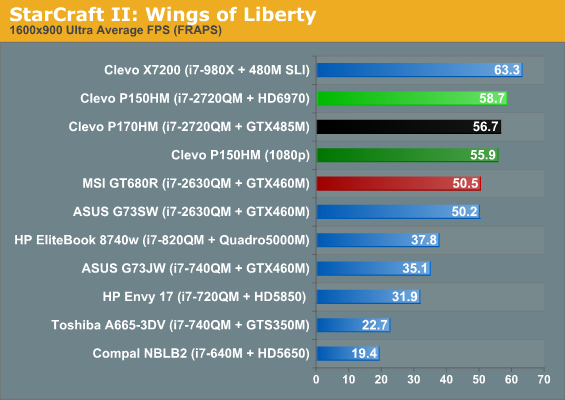
At our high detail settings (which typically means DX9/DX10 and no anti-aliasing, although we do enable 4xAA in L4D2), the Racer/6970M places third in most titles behind the 480M SLI and 485M. Perhaps more telling is that it boasts a performance increase of 16 to 75% over the GTX 460M, all for a minor increase in price. The lower end of that range is because our 900p High settings don’t put quite as much strain on the GPU, as we’ll see once we kick things up to Ultra quality. In fact, even at 1080p versus 900p, the 6970M is 8 to 30% faster than the 460M, and it’s up to 40% faster than the 5870M.
Looking at the head-to-head against the 485M makes things a bit more interesting. AMD leads by as much as 32% in L4D2, with a 4% lead in SC2 and a 5% lead in ME2. NVIDIA turns the tables in the remaining five games, with leads of 8% in BFBC2, 14% in DiRT 2, 16% in Mafia II, 1% in Metro 2033, and 5% in STALKER. It looks like NVIDIA’s 485M is in general the faster GPU, but the popular Source Engine games can really skew the results. Of course, most of these titles are hitting 60+ FPS at our High settings, so let’s set phasers for maximum power and fire a full spread of photon torpedoes.

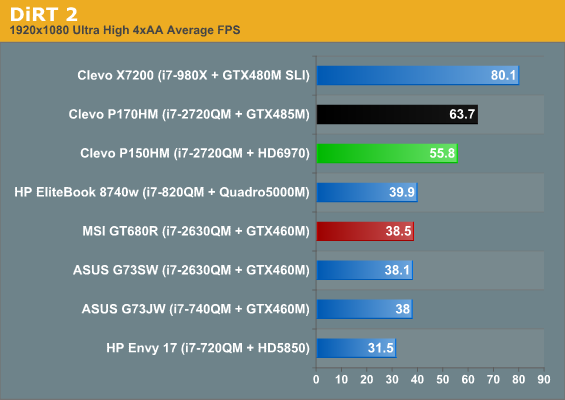

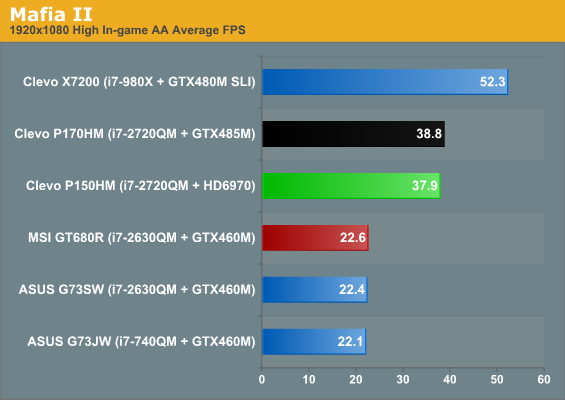
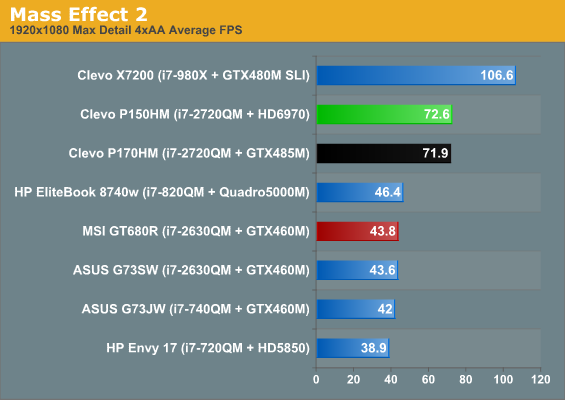
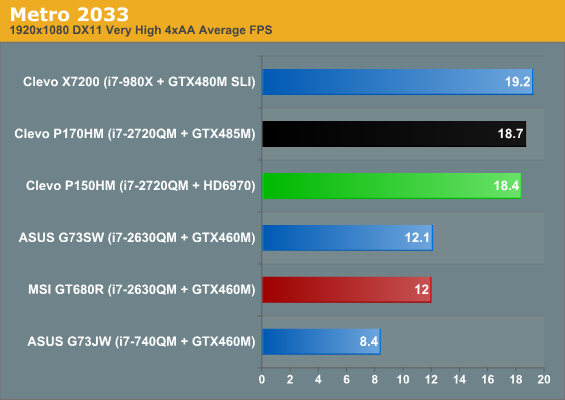
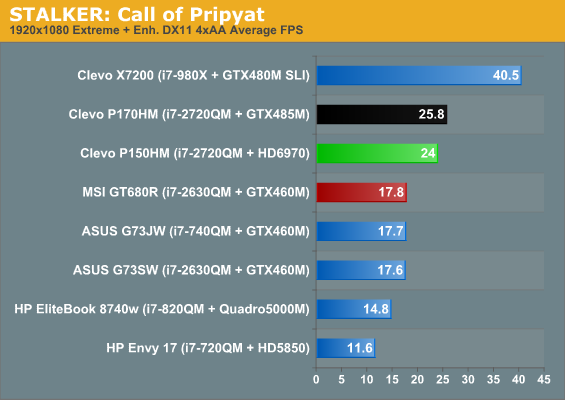
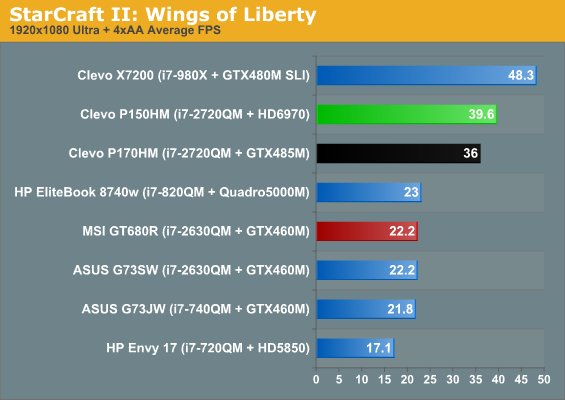
Crank the settings up and watch the frame rates drop. Where most of the games were pulling around 60FPS or higher on the 6970M and 485M, at our Ultra settings only two titles are above 60FPS with the 6970M (three for the 485M), and two more fall below 30FPS. Now granted, 4xAA with Very High/Extreme settings in Metro and STALKER is more than most users would expect out of a notebook; turn off AA in STALKER and the frame rate doubles on the 6970M. Still, many desktops are able to handle this sort of resolution/settings combination on midrange ($200) hardware, so when an $1800+ notebook with the fastest GPU you can currently get falls short it’s a bit disappointing.
Comparing the 6970M and 485M once more, we find NVIDIA with a slight lead in five of the eight games, but if we call anything less than a 5% difference a tie there are really only three games where there’s even a moderate difference. NVIDIA is ahead by 8% in STALKER and 14% in DiRT 2; AMD leads by 10% in StarCraft II. Everything else is splitting hairs. The 6970M puts the hurt on the 460M once again, with performance now 35% to 82% higher than the MSI GT680R.
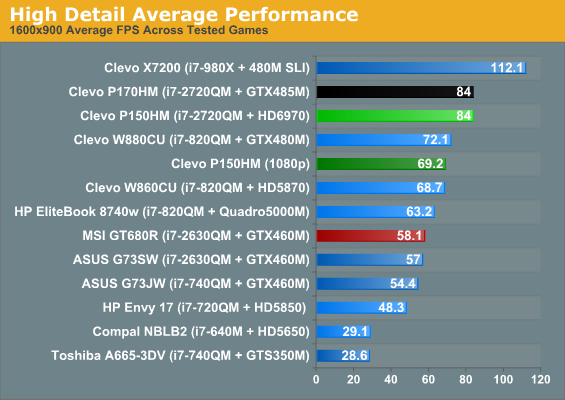

As a final look at gaming performance, we averaged all the scores across the tested games, at both our High and our Ultra detail settings. Notebooks where we don’t have scores for all eight games are shown in light blue, so take those figures with a grain of salt. We do have full results for the 460M, 485M, and 6970M, though, so we’ll focus on those areas.
First, it’s interesting to note that the 485M and 6970M end up tied once we average our test suite frame rates. At High, the very good performance of AMD in L4D2 obscures the fact that NVIDIA usually leads, but at Ultra things are so close that calling it a draw seems reasonable. If you place more value on, say, STALKER you might go the NVIDIA route; StarCraft II addicts might prefer AMD. Ultimately, we’ll give NVIDIA the slight edge in subjective performance (and we still need to look at power and battery life), but cost definitely looks to be in AMD’s favor. As for the 460M, depending on which notebook you want to compare to and what detail settings, AMD ends up 45 to 54% faster at High detail (and still 19% faster running 1080p High), and the margin grows to 63 to 70% faster at Ultra detail.










47 Comments
View All Comments
freezervv - Thursday, March 17, 2011 - link
Re: "by Jarred Walton on 3/17/2011 3:00:00 AM"Or at least those of us ESTers just getting around to a catnap amidst exam studying. ;)
JarredWalton - Thursday, March 17, 2011 - link
Hey, I'm PDT, so it's only just past midnight. And here I thought I'd be finished with this about six hours ago....poohbear - Thursday, March 17, 2011 - link
hello, can you guys please list the price or price segment of the product u're reviewing from the get go? Do i really hafta scroll all the way to the back to get an idea of what the price range is, or if its a waste of time reading the article cause its out of said price range? U're constantly saying it costs more or this costs less, but there's no clear cut price easy for us readers to see. A comparison of similar products would be great too, in a clean easy to understand graph please and thank u!JarredWalton - Thursday, March 17, 2011 - link
Page one, bottom of the spec table, in bold. Was that not clear enough?chrnochime - Friday, March 18, 2011 - link
Bottom of the spec like Jarred said. Need that to be 3 or 4 larger font size?jcompagner - Thursday, March 17, 2011 - link
And then for SandyBridge?If only 1 17" is made with a 1920x1200p resolution on this planet that is not from apple, i would buy it immediately..
piroroadkill - Thursday, March 17, 2011 - link
Well, the Dell Precision M6500 has a 1920x1200 screen, 17".. and was reviewed on Anandtech.But it's not Sandy Bridge yet. I'd imagine a good supply of new Sandy Bridge chipsets aren't common, but I'd have no doubt at all Dell will do a refresh on their Precision line with Sandy Bridge at some point in the near future. It also looks about a million times better than the Clevo stuff, which looks like a ghetto kit machine.
bobsmith1492 - Thursday, March 17, 2011 - link
I bought a Sager back in 2005 with a 1920x1200 matte screen. It's still up and running, though relatively slow these days and a few things are broken now.blah238 - Thursday, March 17, 2011 - link
In my 3DMark Vantage settings, the "Performance" preset equates to 1280x1024, whereas "High" is 1680x1050. Did you have to use custom settings to get 1680x1050 or is there just a mixup of names?JarredWalton - Thursday, March 17, 2011 - link
Sorry, my mistake. I got the High default resolution of 1680x1050 confused with Performance. 1280x1024 panels are such a rarity these days that I was sure Vantage had switched to WS for everything. 3DMark11, interestingly enough, did shift to new resolutions. 1024x600 for Entry and 1600x900 for Performance I believe, with 1080p used at the High setting. About time...Now, if Futuremark would quit being idiots about changing my power settings every time I load one of their apps. Seriously: tweak all your power settings (i.e. don't put the LCD to sleep or hibernate the laptop after inactivity), then load any Futuremark app. When you're done, the power settings are now "display off after 5 minutes, ask for a password on resume, and hibernate/shut down with a low battery even when plugged in." Is it too much to think they should save my current settings and then restore them when the benchmark is done?